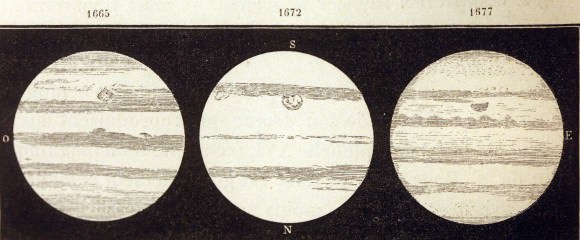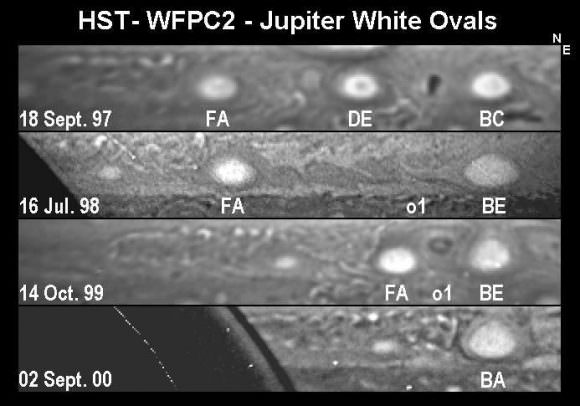https://www.youtube.com/watch?v=_ABKMoWKHjo
When we used to do the Virtual Star Party (and I really need to start those up again, they were super fun), I had the worst luck with Jupiter’s Great Red Spot. Whenever Jupiter was in the sky, the Great Red Spot always eluded us. Even though we should have had a 50/50 shot at seeing the massive storm on Jupiter, it was always hiding. Why so shy Jovian storm?
Jupiter’s Great Red Spot is an enormous swirling storm located on a band of clouds just south of the planet’s equator. It’s been there as long as people have been observing Jupiter with good enough telescopes to resolve it.
Astronomers somewhat disagree exactly when that was. The first person to mention a spot on Jupiter was Robert Hooke, who described it in 1664, but he placed it in the northern hemisphere. Oops.
A more reliable account comes from Giovanni Cassini, best known for his observations of Saturn. He observed a permanent spot in roughly the same location from 1665 to 1713.

The strange part is that astronomers lost track of it until 1830, when the modern Spot we know today was clearly evident. Were they two different spots? Did the GRS disappear and the flare up again? We’ll never know.
But really, isn’t that just splitting hairs? The thought that there’s been an enormous Jovian hurricane swirling away for hundreds of years is awesome and terrifying.
Here on Earth, we classify hurricanes as Category 1 when the wind speed crosses 119 km/h. A Category 4 hurricane can hit more than 250 km/h. That’s scary fast wind speed that can tear apart buildings. The Great Red Spot, on the other hand, can reach almost 650 km/h.
How big is this thing, anyway? Trust me, it’s big, but it used to be bigger. When astronomers first started keeping accurate measurements in the late 1800s, the Great Red Spot was about 40,000 kilometers wide and 14,000 kilometers tall.
Since that time, it’s been steadily shrinking. When the Voyager spacecraft flew past in the late 1970s, the spot had shrunk to 23,000 kilometers across. In 1995 Hubble measured it as 21,000 kilometers across, and then again in 2009, it was 18,000 kilometers across. About a year ago, Hubble did another measurement, and now it’s only 16,500 kilometers wide.
I say “only”, but keep in mind that the Earth measures 12,742 kilometers across. In other words, the Great Red Spot could still swallow up an Earth with room to spare.

But this shrinking is continuing by about 930 kilometers per year. And as it shrinks, it’s changing from an oval to a more circular shape. At the same time, the color is changing too, lightening up – perhaps because the storm doesn’t dig too deeply into the lower atmospheric layers.
It’s possible that the Great Red Spot could completely disappear within our generation. And then every astronomer would fail to be able to see the Spot, just like me.
The Great Red Spot isn’t the only long lived storm on Jupiter, and this could be the reason why the Spot is disappearing.
If you look at images of Jupiter from Hubble, you can see other cyclonic storms; the biggest of which is known as Oval BA. It was first observed in 2000, after a few smaller storms collided and merged into a little red spot.

Over time, Oval BA has been getting larger and stronger, now it’s about the size of the Earth, and wind speeds have reached more than 600 km/h rivalling the Great Red Spot.
Because the bands on Jupiter alternate in directions, astronomers think that storms on the nearby bands are sapping the strength of the Great Red Spot. And perhaps they’re boosting Oval BA. There might be a time when the two spots are roughly the same size. And when the Great Red Spot finally disappears, Oval BA will be there to assume the mantle.
Since these storms can clearly grow and shrink over hundreds of years, I wonder what some of the strangest configurations of storms have ever been. I guess future robot-body Fraser will be the one to find out.
Good news! At the time that you’re watching this, NASA’s Juno spacecraft arrived at Jupiter on July 4, 2016. For the first time in more than a decade, we have a dedicated spacecraft at Jupiter, mapping, probing and analyzing the giant planet.
We should be getting more close up measurements and observations of the Great Red Spot and everything Jovian, so stay tuned, it’s going to be exciting.


Are there any theories regarding the Spot that consider the possibility of sub-atmospheric volcanic activity – knowing the planet is a gas-giant, do we really know what is beneath the surface? Perhaps the source of the heat is coming from within the planet itself and is caused by subsurface super-heated liquid matter, much like the core of Earth? This might explain the longevity and relative stationary location of the spot.